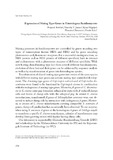Mostrar el registro sencillo del ítem
Expression of mating type genes in heterologous basidiomycetes
| dc.creator | Srivilai, Prayook | es_ES |
| dc.creator | James, Timothy Y. | es_ES |
| dc.creator | Vilgalys, Rytas | es_ES |
| dc.creator | Chaiseana, Wassana | es_ES |
| dc.creator | Kües, Ursula | es_ES |
| dc.date.accessioned | 2018-02-14T09:31:33Z | |
| dc.date.available | 2018-02-14T09:31:33Z | |
| dc.date.issued | 2006 | |
| dc.identifier.isbn | 84-9769-107-5 | |
| dc.identifier.uri | https://hdl.handle.net/2454/27227 | |
| dc.description | Resumen de la conferencia presentada al VI Meeting on Genetics and Cellular Biology of Basidiomycetes (GCBB-VI), organizado por y celebrado en la Universidad Pública de Navarra el 3-6 de junio de 2005. | es_ES |
| dc.description.abstract | Mating processes in basidiomycetes are controlled by genes encoding two types of transcription factors (HD1 and HD2) and by genes encoding pheromones and pheromone receptors. For a successful mating reaction, an HD1 protein and an HD2 protein of different specificity have to interact and a pheromone with a pheromone receptor of different specificity. With now having cloned mating type loci from several different basidiomycetes, evolution of these loci and their genes can be addressed by sequence analysis as well as by transformation of genes into heterologous species. Transformation of cloned mating type genes into strains of the same species with different mating type genes can activate mating type controlled development. The A mating type genes of Coprinopsis scobicola and of Coprinellus disseminatus were found to be functional in Coprinopsis cinerea in combination with the endogenous A mating type genes. Moreover, B genes of C. disseminatus in C. cinerea cause peg formation subapical to septa with A-induced clamps cells and fusion of clamp cells with the subapical peg. In several C. cinerea monokaryons, transformed A genes of Schizophyllum commune were not observed to induce clamp cells by interaction with endogenous A genes. However, in crosses of C. cinerea transformants carrying compatible S. commune A genes, clamp cell production has occasionally been observed. To our surprise, when using S. commune A genes or the homologous b genes of Ustilago maydis to transform a specific C. cinerea monokaryon, colonies of transformants may develop faster growing sectors with hyphae having clamp cells. Our laboratory is supported by Deutsche Bundesstiftung Umwelt (DBU) and scholarships by the Mahasarakham University (to PS) and the Rajamangala Institute of Technology (to WC). | en |
| dc.description.sponsorship | The author's laboratory is supported by Deutsche Bundesstiftung Umwelt (DBU). Scholarships by the Mahasarakham University (to PS) and the Rajamangala Institute of Technology (to WC). | en |
| dc.format.extent | 1 p. | |
| dc.format.mimetype | application/pdf | en |
| dc.language.iso | eng | en |
| dc.publisher | Universidad Pública de Navarra / Nafarroako Unibertsitate Publikoa | es |
| dc.relation.ispartof | Antonio G. Pisabarro and Lucía Ramírez (eds.): VI Meeting on Genetics and Cellular Biology of Basidiomycetes (GCBB-VI). Pamplona: Universidad Pública de Navarra / Nafarroako Unibertsitate Publikoa, 2006. | es |
| dc.rights | © Autores; Universidad Pública de Navarra. Esta publicación no puede ser reproducida, almacenada o transmitida total o parcialmente, sea cual fuere el medio y el procedimiento, incluidas las fotocopias, sin permiso previo concedido por escrito por los titulares del copyright. | es_ES |
| dc.subject | Heterologous basidiomycetes | en |
| dc.subject | Mating type genes | en |
| dc.title | Expression of mating type genes in heterologous basidiomycetes | en |
| dc.type | info:eu-repo/semantics/conferenceObject | en |
| dc.type | Contribución a congreso / Biltzarrerako ekarpena | es |
| dc.rights.accessRights | info:eu-repo/semantics/openAccess | en |
| dc.rights.accessRights | Acceso abierto / Sarbide irekia | es |
| dc.type.version | info:eu-repo/semantics/publishedVersion | en |
| dc.type.version | Versión publicada / Argitaratu den bertsioa | es |


